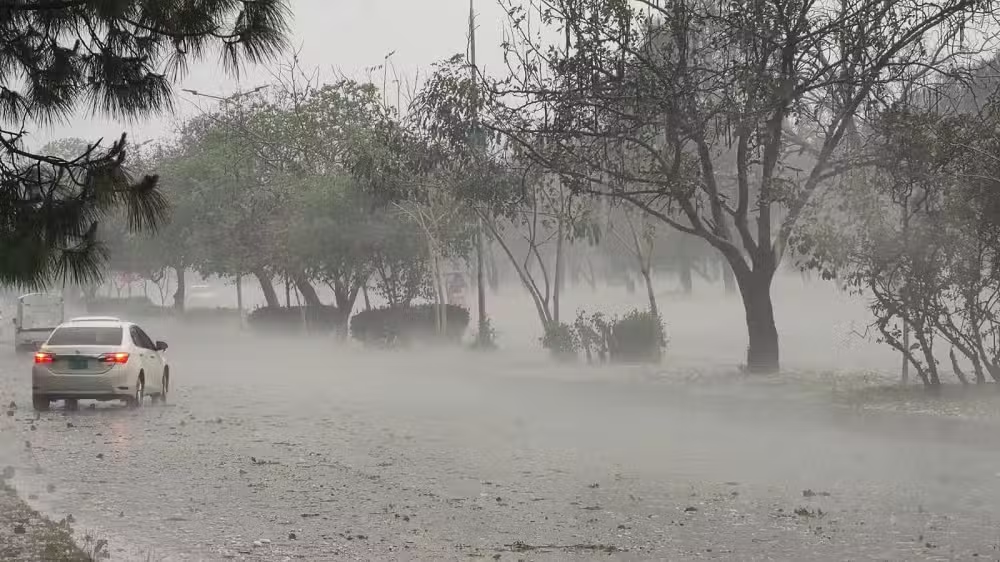The National Disaster Management Authority (NDMA) has declared a high-alert travel advisory for various regions in Khyber Pakhtunkhwa (KP), forecasting an onslaught of intense rainfall, hailstorms, and thunderstorms over the next 12 hours.
The NDMA has strongly urged residents and travelers to exercise extreme caution, particularly in Hazara and Malakand divisions, where landslide risks are especially high.
Regions Under Immediate Threat
The NDMA’s National Emergency Operations Center (NEOC) has pinpointed several high-risk areas that could bear the brunt of this extreme weather event. These include:
- Malakand Division
- Hazara Division
- Bannu
- Charsadda
- Karak
- Khyber
- Kohat
- Kurram
- Lakki Marwat
- Mardan
- Nowshera
- Orakzai
- Peshawar
- Swabi
- Waziristan
Each of these districts is currently under surveillance as heavy downpours, gusty winds, and hailstorms are expected to hit with high intensity, potentially causing significant disruption.
Meteorological data indicates that the incoming storm system could bring torrential rain, strong wind gusts, and large hailstones, significantly raising the risk of:
- Flash floods in low-lying regions
- Landslides in hilly and mountainous areas
- Damage to infrastructure such as roads, bridges, power lines, and buildings
- Disruption to transportation networks
- Destruction of standing crops and vulnerable home.
Severe Weather Forecast and Potential Hazards
- Avoid all non-essential travel to hilly, mountainous, and high-risk regions.
- Confirm road conditions with local authorities before departure.
- Do not attempt to cross flooded roads, rivers, or streams, even in vehicles.
- Stay updated with weather reports and alerts from NDMA and the Pakistan Meteorological Department (PMD).
Motorists, in particular, should be prepared for sudden road closures, reduced visibility, and slippery conditions, especially during and after hailstorms.
- Secure loose objects like solar panels, antennas, and garden furniture that may be displaced by strong winds.
- Reinforce rooftops and weak structures, particularly in rural and semi-urban zones.
- Move livestock and farm equipment to safe shelters.
- Ensure emergency kits with flashlights, water, food, and first aid supplies are readily accessible.
- Unplug electronic appliances during thunderstorms to prevent electrical damage.
Local communities are also advised to coordinate with district disaster management authorities and report any signs of flooding or slope instability immediately.
- Destruction of wheat, maize, and vegetable crops
- Soil erosion due to runoff
- Increased pest activity following prolonged damp conditions
Simultaneously, the power supply infrastructure is under threat from falling trees, pole collapses, and system overloads. Power distribution companies have been notified to prepare for possible damage and initiate rapid-response mechanisms.
Emergency Services and Public Coordination
All emergency response teams have been placed on high alert, with resources pre-deployed in strategic zones to ensure timely intervention. NDMA’s coordination with:
- Provincial Disaster Management Authority (PDMA) KP
- Rescue 1122
- Civil Defence
- Local law enforcement
Residents are urged to adhere strictly to official instructions, especially evacuation orders, shelter guidance, and helpline numbers issued by local authorities.
- SMS alerts via cellular networks
- Social media updates on platforms like Twitter and Facebook
- Local radio and TV bulletins
- Coordination with mosques and community centers for announcements
This rapid dissemination ensures that even remote or rural communities receive timely information about changing conditions. While government mechanisms are in place, community cooperation is vital. Local leaders, volunteers, and citizen groups are encouraged.
- Assist in evacuation efforts
- Provide community shelters for displaced families
- Support first aid and basic relief distribution
- Educate residents on landslide and flood preparedness


